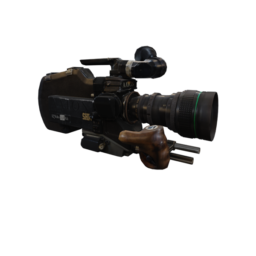Aaton

Aaton Podcast (4:51)
Note: Text in square brackets describes the soundscape as well as certain specific or occasional sounds.
[Atmosphere of a crowd at a festival. Laughter]
Narrator: It’s incredible!
This summer, I went to an amazing music festival! Using my phone, I filmed interviews with my friends. I asked them a bunch of questions throughout the day: What’s your favorite song of the summer? Can you sing it for me?
[The crowd shouts and applauds]
The singer of the band : I can’t hear you! Louder!
[The crowd shouts louder. Pop music begins]
Narrator : I wish I was there right now!
[Festival music stops. Theme music begins: soft piano melody]
Narrator: Like many others around me, I captured my favorite band’s performance on my cell phone. On top of shooting great images, I’m lucky that my phone can also record good sound!
But when exactly were filmmakers able to record images and sound at the same time, without being restricted by a long cable that connected the camera to the sound recorder?
[Theme music ends. Beginning of a drum solo]
Narrator: In 1988, Canadian documentary filmmaker André Gladu travelled to the city of New Orleans to shoot his feature film Liberty Street Blues.
This American city is like no other: thanks to its rich culture, New Orleans is well known for its festivals and music.
[Jazz music accompanies the rest of the narration]
Narrator: To capture the unique city’s jazz scene, André Gladu and his film crew chose to shoot their film with an Aaton 16mm.
The Aaton company was created in France by film engineer Jean-Pierre Beauviala in 1971. Beauviala wanted to find a solution to shoot films more spontaneously. After two years of research and technical trials, the French firm launched the Aaton 7 in 1975. It was designed to be placed on the camera operator’s shoulder. Nicknamed “A cat on the shoulder,” the Aaton 7 is a lightweight camera that is about the same size and weight as the beloved pet. Finally, this silent camera can be synchronized with a sound recorder, without a cable!
This new feature of the Aaton has contributed to the evolution of documentary cinema. Have you ever heard of direct cinema, a movement that has marked the history of Quebecois filmmaking?
[End of jazz music. Transition to outdoor jazz music]
Narrator: The goal of direct cinema was to capture the words and bodies of individuals in an authentic way during their daily activities. Shot with a small crew, Liberty Street Blues was inspired by direct cinema techniques.
The film crew quickly prepares for their shoot: they don’t use artificial lighting, a tripod or a predefined script. Before immersing himself into the lively parade, cinematographer Martin Leclerc loads the Aaton with 16mm film and inserts the battery with the help of his assistant. He then places the camera on his shoulder and his eye on the viewfinder to see the frame. He grasps the wooden handle of the camera to guide it; his other hand adjusts the focus.
The crew is ready to dive into the parade to capture the spirit of the party. Leclerc frames spontaneously — he reacts to the crowd of dancers, musicians, and people of all ages around him. Since the sound equipment is no longer connected to the camera by a cable, the sound engineer and cameraman are free to move through the crowd without limiting each other’s movements.
When the cinematographer places the Aaton on his shoulder, the camera allows him to be as close as possible to what he is filming, without the risk of musicians and dancers tripping over a cable!
[Back to the music festival at the beginning. Laughter]
Narrator: Dance with me!
While I shot my first festival experience entirely on my phone, fifty years ago, a pioneer of direct cinema could have shot this scene too… with a cat — or, an Aaton — on her shoulder!
[Theme music plays again: soft piano melody]
Narrator: To discover more cameras, listen to the other podcasts.